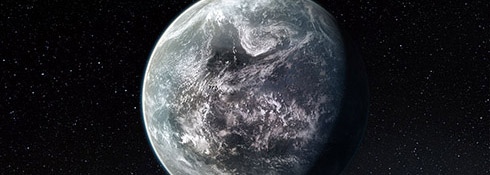 Origin and Evolution of Stars and Planets
Origin and Evolution of Stars and Planets
PI: Margarida S. Cunha (since 1 April 2012)
Team members
The key objective of the team is to address important issues of the physics that drives the
formation and evolution of stars and planets, including in particular the questions on
- How do stars form?
- How do planetary systems form and evolve?
- What is the diversity of planetary systems in the galaxy?
- Do we understand stellar structure and evolution?
Star Formation and Early Evolution
Task leader: J. F. Gameiro
 Image courtesy of M. S. Nanda Kumar
Image courtesy of M. S. Nanda Kumar
Our goal is to conduct unbiased, wide field, multi-wavelength observations of galactic
molecular clouds and its young stellar objects (YSO) content in the embedded clusters
(EC) and halo. Studies of the structure and dynamics of ECs and comparing observational results
to the star formation simulations are our focus. Understanding the formation of massive
stars is also a primary theme. We use infrared-mm observations and radiative transfer models
to study candidate massive protostellar objects.
>> See more
Planetary Systems
Task leader: Nuno C. Santos
 Image credit: ESO
Image credit: ESO
Extra-solar planet research primarily focus on the detection and characterization of
planets
orbiting solar-type stars. We currently have privileged access to top-class facilities, like
HARPS (ESO), and we are active members in other state-of-the-art planet search surveys using
radial-velocities and the photometric transit method. Particular emphasis is given to the detection
of very low-mass (Earth- or Neptune-like) planets, and to the study of the physical properties
of planet-hosting stars (mass, age, chemical abundances).
>> See more
Stellar Interiors and Atmospheres
Task leader: M. J. P. F. G. Monteiro
 Image credit: NASA
Image credit: NASA
One important goal of the team is to understand the details of the
structure and evolution of stars of low and intermediate masses. To
pursue this goal, the team explores a technique known as
Asteroseismology, which is based on the study of stellar oscillations.
These activities are supported by the team's participation in the
French-led mission CoRoT, launched in December 2006, in the Kepler
Asteroseismic Science Consortium for the NASA mission, Kepler, launched
in March 2009, and the participation in a consortium for the ESA mission
PLATO, currently under study.
>> See more
 Origin and Evolution of Stars and Planets
Origin and Evolution of Stars and Planets






















 Image courtesy of M. S. Nanda Kumar
Image courtesy of M. S. Nanda Kumar Image credit: ESO
Image credit: ESO Image credit: NASA
Image credit: NASA